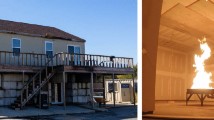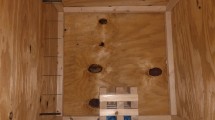Abstract
Gas cooling is a technique used by firefighters to reduce the dangers posed by the hot smoke in enclosure fires and, to thereby approach a fire while keeping their escape route safe. The technique includes bursts of water from a fog nozzle producing small droplets into the hot gases. The purpose of this work was to experimentally investigate the effects of gas cooling. A total of 44 tests were conducted in an 1800 × 1200 × 1200 mm room with an added fire room sizing 1200 × 760 × 1200 mm. A gas burner with a RHR of approximately 90 kW was used as a heat source. Four different nozzles were used, differing in droplet size, flow, and spray pattern. Also, reach, number of bursts and open time of the nozzles varied between tests. In this paper, six of the test with the most important and pronounced results were used for comparison. Conclusions from the tests included that nozzles producing droplets with a median diameter of approximately 500 µm delivered in multiple short burst with time in between bursts kept as short as possible were most effective for gas cooling. However, overall in this experimental setup taking all droplets sizes into consideration, a single longer burst performed slightly better than several short bursts as a similar temperature reduction is achieved in 1/3rd of the time of 5 short bursts and gases are cooled over a larger part of the room. The volume of the smoke was not observed to change significantly due to gas cooling.













Similar content being viewed by others
Abbreviations
- a:
-
Proportion of water that vaporizes
- Ao,x :
-
Area of opening to compartment x
- At,x :
-
Total enclosure area of compartment x
- b:
-
Proportion of water that vaporizes due to the heat of the smoke
- cp :
-
Specific heat capacity (J/kg K)
- cp,sm :
-
Specific heat capacity of smoke (33.2 J/mol K)
- cp,st :
-
Specific heat capacity of steam (41.2 J/mol K at 1000 K)
- cp,w :
-
Specific heat capacity of water (75.31 J/mol K)
- d0 :
-
Initial droplet diameter (m)
- H0,x :
-
Height of opening to compartment x
- k:
-
Conductivity of smoke (W/mK)
- lmax :
-
Maximum fall length of a droplet (m)
- Lv :
-
Heat of vaporization (kJ/kg)
- Lv :
-
Heat of vaporization/latent heat (J/kg)
- Lv,w :
-
Latent heat of water (2260 J/g)
- m:
-
Mass (kg)
- Mw :
-
Molecular weight of water (18 g/mol)
- n:
-
Molar amount
- Nu:
-
Nusselt number
- Q:
-
Energy (J)
- T:
-
Temperature (K)
- tlife :
-
Time for a droplet to evaporate (s)
- v:
-
Droplet falling velocity (m/s)
- ρ:
-
Density (kg/m3)
- RHR:
-
Rate of heat release
- sm:
-
Smoke
- sm + st:
-
Smoke + water
- w:
-
Water
References
Lambert K (2012) Gas cooling: a new approach. www.cfbt-be-com. Accessed 16 Aug 2016
Grimwood P (1994) A comparison of 3D water-fog versus straight streams, using “burst & pause” cycles, to cool & inert dangerous fire gases in the overhead of a compartment fire. http://www.highrisefirefighting.co.uk. Accessed 16 Aug 2016
Hartin E (n.d.) 3D firefighting|compartment fire behavior training. http://cfbt-us.com/wordpress/?tag=3d-firefighting. Accessed 16 Aug 2016
Lambert K, Baaij S (2015) Fire dynamics: technical approach, tactical application. Sdu Uitgevers, The Hague
Grimwood P, Desmet K (2003) Tactical firefighting, a comprehensive guide to compartment firefighting & live fire training (CFBT). www.eurofirefighter.com. Accessed 19 Oct 2017
Grimwood P, Hartin E, McDonough J, Raffel S (2005) 3D fire fighting training, techniques and tactics. Fire Protection Publications, Stillwater
Hartin E (2010) Gas cooling. http://cfbt-us.com/wordpress/?p=1212. Accessed 16 Aug 2016
Svensson S (2002) The operational problem of fire control. Lund University. In: SFPE handbook of fire protection engineering, 5th edn. Springer
Särdqvist S (2002) Water and other extinguishing agents. Swedish Rescue Services Agency, Karlstad
Svensson S (2002) The operational problem of fire control. Lund University, Lund
Hartin E (2010) Gas cooling: part 5. http://cfbt-us.com/wordpress/?p=1299. Accessed 18 Jan 2018
Herterich, O. (1960). Wasser al Löschmittel: anwendung und technik im Brandschutz. Dr Alfred Hüthig Verlag GMBH, Heidelberg
Alageel S (1999) Mitigation of compartment jet fires using water sprays. The University of Sheffield, Sheffield
ISO 9705, Reaction to fire test: room corner test for wall and ceiling lining products
Karlsson B, Quintiere JG (2000) Enclosure fire dynamics. CRC Press LLC, Raton
Data sheet cembrit multi force. http://www.cembrit.se. Accessed 17 Aug 2016
Spraying Systems Co. www.spray.com. Accessed 17 Aug 2016
Van de Veire M. (2016) Studies on the importance of firefighters’ gas cooling (report 5515). Department of Fire Safety Engineering ,Lund
Akron Force data sheet, (Measurement report, Ref 971428X5, 1998), Akron Brass Company, Wooster, Ohio
Author information
Authors and Affiliations
Corresponding author
Additional information
Publisher's Note
Springer Nature remains neutral with regard to jurisdictional claims in published maps and institutional affiliations.
Rights and permissions
About this article
Cite this article
Svensson, S., Van de Veire, M. Experimental Study of Gas Cooling During Firefighting Operations. Fire Technol 55, 285–305 (2019). https://doi.org/10.1007/s10694-018-0790-3
Received:
Accepted:
Published:
Issue Date:
DOI: https://doi.org/10.1007/s10694-018-0790-3




